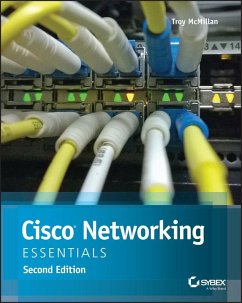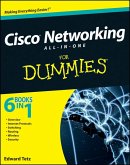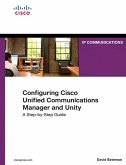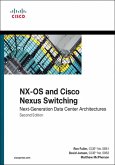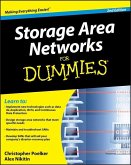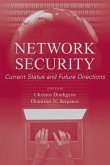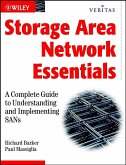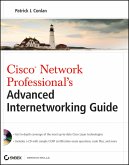Cisco Networking Essentials (eBook, PDF)


Alle Infos zum eBook verschenken

Cisco Networking Essentials (eBook, PDF)
- Format: PDF
- Merkliste
- Auf die Merkliste
- Bewerten Bewerten
- Teilen
- Produkt teilen
- Produkterinnerung
- Produkterinnerung

Hier können Sie sich einloggen

Bitte loggen Sie sich zunächst in Ihr Kundenkonto ein oder registrieren Sie sich bei bücher.de, um das eBook-Abo tolino select nutzen zu können.
Start a career in networking Cisco Networking Essentials, 2nd Edition provides the latest for those beginning a career in networking. This book provides the fundamentals of networking and leads you through the concepts, processes, and skills you need to master fundamental networking concepts. Thinking of taking the CCENT Cisco Certified Entry Networking Technician ICND1 Exam 100-101? This book has you covered! With coverage of important topics and objectives, each chapter outlines main points and provides clear, engaging discussion that will give you a sound understanding of core topics and…mehr
- Geräte: PC
- mit Kopierschutz
- eBook Hilfe
- Größe: 110.76MB
![Cisco Networking All-in-One For Dummies (eBook, PDF) Cisco Networking All-in-One For Dummies (eBook, PDF)]() Edward TetzCisco Networking All-in-One For Dummies (eBook, PDF)29,99 €
Edward TetzCisco Networking All-in-One For Dummies (eBook, PDF)29,99 €![Configuring Cisco Unified Communications Manager and Unity Connection (eBook, PDF) Configuring Cisco Unified Communications Manager and Unity Connection (eBook, PDF)]() David J. BatemanConfiguring Cisco Unified Communications Manager and Unity Connection (eBook, PDF)28,95 €
David J. BatemanConfiguring Cisco Unified Communications Manager and Unity Connection (eBook, PDF)28,95 €![NX-OS and Cisco Nexus Switching (eBook, PDF) NX-OS and Cisco Nexus Switching (eBook, PDF)]() Ron FullerNX-OS and Cisco Nexus Switching (eBook, PDF)28,95 €
Ron FullerNX-OS and Cisco Nexus Switching (eBook, PDF)28,95 €![Storage Area Networks For Dummies (eBook, PDF) Storage Area Networks For Dummies (eBook, PDF)]() Christopher PoelkerStorage Area Networks For Dummies (eBook, PDF)21,99 €
Christopher PoelkerStorage Area Networks For Dummies (eBook, PDF)21,99 €![Network Security (eBook, PDF) Network Security (eBook, PDF)]() Christos DouligerisNetwork Security (eBook, PDF)113,99 €
Christos DouligerisNetwork Security (eBook, PDF)113,99 €![Storage Area Network Essentials (eBook, PDF) Storage Area Network Essentials (eBook, PDF)]() Richard BarkerStorage Area Network Essentials (eBook, PDF)61,99 €
Richard BarkerStorage Area Network Essentials (eBook, PDF)61,99 €![Cisco Network Professional's Advanced Internetworking Guide (CCNP Series) (eBook, PDF) Cisco Network Professional's Advanced Internetworking Guide (CCNP Series) (eBook, PDF)]() Patrick J. ConlanCisco Network Professional's Advanced Internetworking Guide (CCNP Series) (eBook, PDF)54,99 €
Patrick J. ConlanCisco Network Professional's Advanced Internetworking Guide (CCNP Series) (eBook, PDF)54,99 €-
-
-
Dieser Download kann aus rechtlichen Gründen nur mit Rechnungsadresse in A, B, BG, CY, CZ, D, DK, EW, E, FIN, F, GR, HR, H, IRL, I, LT, L, LR, M, NL, PL, P, R, S, SLO, SK ausgeliefert werden.
- Produktdetails
- Verlag: John Wiley & Sons
- Seitenzahl: 480
- Erscheinungstermin: 13. August 2015
- Englisch
- ISBN-13: 9781119092124
- Artikelnr.: 43665685
- Verlag: John Wiley & Sons
- Seitenzahl: 480
- Erscheinungstermin: 13. August 2015
- Englisch
- ISBN-13: 9781119092124
- Artikelnr.: 43665685
- Herstellerkennzeichnung Die Herstellerinformationen sind derzeit nicht verfügbar.
Chapter 1 Networks 1
Describing Network Components 1
Defining the Benefits of Networks 2
Identifying the Requirements for a Network 5
Classifying Networks by Function 8
Understanding LANs 9
Understanding WANs 10
Defining Network Architectures 10
Understanding Peer-to-Peer Networks 11
Understanding Client-Server Networks 14
The Essentials and Beyond 17
Chapter 2 The OSI Model 19
Using Reference Models 19
Understanding the Benefits of Reference 21
Exploring Reference Model Examples 21
Introducing the Layers of the OSI Model 22
Understanding the Application Layer 23
Understanding the Presentation Layer 24
Understanding the Session Layer 26
Understanding the Transport Layer 26
Understanding the Network Layer 30
Understanding the Data-Link Layer 31
Understanding the Physical Layer 33
Describing the OSI Encapsulation Process 33
Identifying the Process on the Source Device 34
Identifying the Process on the Destination Device 35
The Essentials and Beyond 36
Chapter 3 TCP/IP 39
Understanding the TCP/IP Model 40
Exploring the Four Layers 41
Comparing the OSI and TCP/IP Models 44
Describing the TCP/IP Encapsulation Process 46
Understanding Data and PDUs 46
Describing the Contents of Data 47
Describing the Contents of Segments 47
Describing the Contents of Packets 47
Describing the Contents of Frames 47
Understanding the Conversion to Bits 48
Describing the Functions at the Transport Layer 50
Understanding TCP 50
Understanding UDP 51
Describing the Functions at the Internet Layer 52
Defining Logical Addressing 53
Performing Routing 54
Accomplishing Packet Forwarding 54
Describing the Functions of ARP 55
Illustrating the ARP Broadcast 55
Describing the Logic of MAC-to-IP-Address Conversion 57
The Essentials and Beyond 59
Chapter 4 Protocols 63
Understanding the Function of Protocols 64
Defining Routed Protocols 64
Defining Routing Protocols 64
Exploring Application Layer Protocols 65
Describing FTP 65
Describing TFTP 67
Describing SMTP 67
Describing DNS 69
Describing SNMP70
Exploring Transport Layer Protocols 72
Reviewing TCP 72
Reviewing UDP76
Exploring Internet Layer Protocols 77
Describing IP 77
Describing ARP 79
Describing ICMP 80
Describing IGMP 82
Exploring Network Access Layer Protocols 83
Defining Network Access Layer Protocols on the LAN 84
Defining Network Access Layer Protocols on the WAN 85
The Essentials and Beyond 86
Chapter 5 Physical and Logical Topologies 91
Designing the Physical Topology 91
Implementing a Bus Topology 92
Implementing a Ring Topology 93
Implementing a Star Topology 94
Implementing a Mesh Topology 96
Implementing a Hybrid Topology 97
Implementing a Point-to-Point Topology 98
Implementing a Point-to-Multipoint Topology 100
Designing the Logical Topology 101
Understanding the Token Ring Topology 101
Understanding the FDDI Ring Topology 102
Understanding the Star Topology 103
The Essentials and Beyond 105
Chapter 6 Numbering Systems 109
Exploring Binary Numbering 109
Understanding the Base-2 Numbering System 110
Understanding the Relationship between Binary and Computers 112
Exploring Hexadecimal Numbering 114
Understanding the Base-16 Numbering System 114
Identifying MAC Addresses 116
Applying Conversions 118
Decimal-to-Binary Conversion 118
Hex-to-Decimal Conversion 121
Binary-to-Hex Conversion 123
The Essentials and Beyond 124
Chapter 7 Classful IP Addressing 129
Describing the Function of IP Addresses 129
Identification 130
Segmentation 131
Identifying IP Address Types 132
Defining IP Address Classes 133
Identifying Network and Host Addresses 135
Describing Private IP Addresses and NAT 138
Utilizing Diagnostic Tools 139
Executing the ipconfig Command 141
Executing the ping Command 141
Executing the arp Command 142
Executing the traceroute Command 143
Understanding DHCP 143
Operations 143
Cisco DHCP 145
Introducing IPv6 146
IPv6 Address Format 146
IPv6 Address Types 147
Special IPv6 Addresses 148
The Essentials and Beyond 148
Chapter 8 Classless IP Addressing 153
Understanding the Limitations of Classful Networking 153
Exhaustion of the Class B Network Address Space 154
Unmanageable Routing Tables 154
Exhaustion of the 32-Bit IPv4 Address Space 155
Understanding the Benefi ts of Subnetting 155
Identifying Sources of Network Congestion 156
Deploying Subnetting as a Segmentation Tool 157
Describing the Components of CIDR 158
Introducing Classless Subnetting 158
Designing and Implementing CIDR 160
Understanding VLSM167
Summarization 171
The Essentials and Beyond 172
Chapter 9 Media 175
Selecting the Proper Media Type 175
Bandwidth 176
Security 176
Convenience 180
Cost 180
Understanding Cabling 181
Describing Cable Behavior and Characteristics 181
Describing Physical Implementations 183
Choosing the Correct Wiring Standard 187
Describing Wireless Standards191
Identifying Standards Bodies 191
Understanding 802.11 Amendments 192
Understanding Wireless LAN Components and Terminology 193
Describing CSMA/CA Operation 196
The Essentials and Beyond 198
Chapter 10 Network Devices 201
Describing Device Functions 201
Understanding Repeaters 202
Understanding Hubs 202
Understanding Bridges 203
Understanding Switches 205
Understanding Routers 209
Understanding Wireless Access Points and Wireless Routers 214
Understanding Device Placement Principles 216
Defining Broadcast Domains 216
Defining Collision Domains 217
Understanding the Cisco Three-Layer Model 220
The Essentials and Beyond 221
Chapter 11 LAN Operations 225
Understanding the Routing Process 225
Describing Routing Tables 226
Understanding Population Methods 229
Understanding Administrative Distance 231
Using Routing Protocols 234
Describing the Switching Process 243
Reviewing MAC and IP Addresses 243
Reviewing Contention Methods 244
Describing MAC Address Tables 246
Understanding Frame Forwarding 246
Describing End-to-End Communications 247
Understanding the Local LAN Process 248
Understanding the Remote Communication Process 249
The Essentials and Beyond 250
Chapter 12 Managing the Cisco IOS 253
Describing Components 253
Defining the Contents of RAM 254
Defining the Contents of NVRAM 255
Defining the Contents of Flash 255
Defining the Contents of ROM 256
Describing IOS Navigation 258
Connecting to the Device 258
Accessing User, Privileged, and Global Configuration Modes 262
Understanding and Managing the Boot Process 266
Understanding the Boot Process 267
Managing the IOS 270
Understanding Configuration Files 271
Managing the Configuration Register 272
The Essentials and Beyond 276
Chapter 13 Configuring Routers 281
Cabling the Router 281
Cabling Router to Router 284
Cabling Router to Switch 287
Cabling PC to Router 288
Cabling Router to CSU/DSU 290
Creating a Console Session 292
Connecting with the Console Cable 292
Connecting Through the USB Port 293
Connecting Through Telnet 294
Handling Initial Setup 295
Configuring Passwords 295
Interpreting Prompts 295
Configuring Privileged (Enable) Passwords 296
Configuring Enable Secret Passwords 297
Configuring Line Passwords 297
Configuring Interfaces 299
Accessing Interface Mode 299
Assigning an IP Address 300
Enabling the Interface 301
Verifying the Interface 301
Configuring a Router as a DHCP Server 303
Configuring WAN Interfaces 306
Saving Configuration Changes 308
The Essentials and Beyond 309
Chapter 14 Configuring Switches 315
Cabling the Switch 315
Cabling Switch to Switch 316
Cabling Router to Switch 317
Cabling Hosts to Switch 318
Creating a Session with the Switch 318
Creating a Session with the Console Cable 318
Creating a Session Through Telnet 320
Configuring Passwords321
Configuring Privileged (Enable) Passwords 321
Configuring Enable Secret Passwords 322
Configuring Line Passwords 322
Using the service password-encryption Command 322
Configuring Interfaces 323
Accessing Switchports and Using Switchport Mode323
Enabling the Port 324
Verifying the Port324
Understanding Advanced Switch Functions 325
Understanding VLANs 325
Configuring VLANs 325
Assigning Ports to VLANs 326
Understanding Trunk Ports 327
Configuring Trunk Links 328
Describing STP 328
Understanding Port Security 332
Limiting MAC Addresses 332
Implementing Sticky Mac 333
The Essentials and Beyond 333
Chapter 15 Configuring Static Routing 337
Populating the Routing Table 338
Using the ip route Command 338
Verifying the Route Table 340
Configuring Inter-VLAN Routing 341
Creating a Trunk Link with Encapsulation 342
Creating and Configuring Subinterfaces 343
Troubleshooting VLANs 345
Troubleshooting Trunk Links 346
Troubleshooting Inter-VLAN Routing 347
The Essentials and Beyond 348
Chapter 16 Configuring Dynamic Routing 353
Understanding Routing Protocols 353
Exploring RIP355
Exploring EIGRP 357
Exploring OSPF 358
Configuring Routing Protocols 358
Enabling a Routing Protocol and Accessing Router Mode 359
Defining the Interfaces on Which the Protocol Is Operational 360
Verifying the Routing Table 361
The Essentials and Beyond 367
Chapter 17 Device Security 371
Understanding Access Lists 371
Understanding Standard Access Lists 373
Understanding Extended Access Lists 373
Configuring Numbered Access Lists 374
Configuring Named Access Lists 376
Editing Access Lists Using Sequence Numbers 377
Understanding Network Address Translation (NAT) 378
Implementing Static NAT, Dynamic NAT, and PAT 380
Configuring a Switch or Router as an NTP Client or Server 383
Implementing and Requiring SSH 384
Limiting Remote Access with ACLs 387
The Essentials and Beyond 388
Appendix A Answers to Review Questions 393
Appendix B CCNA Essentials: Ancillary Exercises 407
Index 437
Chapter 1 Networks 1
Describing Network Components 1
Defining the Benefits of Networks 2
Identifying the Requirements for a Network 5
Classifying Networks by Function 8
Understanding LANs 9
Understanding WANs 10
Defining Network Architectures 10
Understanding Peer-to-Peer Networks 11
Understanding Client-Server Networks 14
The Essentials and Beyond 17
Chapter 2 The OSI Model 19
Using Reference Models 19
Understanding the Benefits of Reference 21
Exploring Reference Model Examples 21
Introducing the Layers of the OSI Model 22
Understanding the Application Layer 23
Understanding the Presentation Layer 24
Understanding the Session Layer 26
Understanding the Transport Layer 26
Understanding the Network Layer 30
Understanding the Data-Link Layer 31
Understanding the Physical Layer 33
Describing the OSI Encapsulation Process 33
Identifying the Process on the Source Device 34
Identifying the Process on the Destination Device 35
The Essentials and Beyond 36
Chapter 3 TCP/IP 39
Understanding the TCP/IP Model 40
Exploring the Four Layers 41
Comparing the OSI and TCP/IP Models 44
Describing the TCP/IP Encapsulation Process 46
Understanding Data and PDUs 46
Describing the Contents of Data 47
Describing the Contents of Segments 47
Describing the Contents of Packets 47
Describing the Contents of Frames 47
Understanding the Conversion to Bits 48
Describing the Functions at the Transport Layer 50
Understanding TCP 50
Understanding UDP 51
Describing the Functions at the Internet Layer 52
Defining Logical Addressing 53
Performing Routing 54
Accomplishing Packet Forwarding 54
Describing the Functions of ARP 55
Illustrating the ARP Broadcast 55
Describing the Logic of MAC-to-IP-Address Conversion 57
The Essentials and Beyond 59
Chapter 4 Protocols 63
Understanding the Function of Protocols 64
Defining Routed Protocols 64
Defining Routing Protocols 64
Exploring Application Layer Protocols 65
Describing FTP 65
Describing TFTP 67
Describing SMTP 67
Describing DNS 69
Describing SNMP70
Exploring Transport Layer Protocols 72
Reviewing TCP 72
Reviewing UDP76
Exploring Internet Layer Protocols 77
Describing IP 77
Describing ARP 79
Describing ICMP 80
Describing IGMP 82
Exploring Network Access Layer Protocols 83
Defining Network Access Layer Protocols on the LAN 84
Defining Network Access Layer Protocols on the WAN 85
The Essentials and Beyond 86
Chapter 5 Physical and Logical Topologies 91
Designing the Physical Topology 91
Implementing a Bus Topology 92
Implementing a Ring Topology 93
Implementing a Star Topology 94
Implementing a Mesh Topology 96
Implementing a Hybrid Topology 97
Implementing a Point-to-Point Topology 98
Implementing a Point-to-Multipoint Topology 100
Designing the Logical Topology 101
Understanding the Token Ring Topology 101
Understanding the FDDI Ring Topology 102
Understanding the Star Topology 103
The Essentials and Beyond 105
Chapter 6 Numbering Systems 109
Exploring Binary Numbering 109
Understanding the Base-2 Numbering System 110
Understanding the Relationship between Binary and Computers 112
Exploring Hexadecimal Numbering 114
Understanding the Base-16 Numbering System 114
Identifying MAC Addresses 116
Applying Conversions 118
Decimal-to-Binary Conversion 118
Hex-to-Decimal Conversion 121
Binary-to-Hex Conversion 123
The Essentials and Beyond 124
Chapter 7 Classful IP Addressing 129
Describing the Function of IP Addresses 129
Identification 130
Segmentation 131
Identifying IP Address Types 132
Defining IP Address Classes 133
Identifying Network and Host Addresses 135
Describing Private IP Addresses and NAT 138
Utilizing Diagnostic Tools 139
Executing the ipconfig Command 141
Executing the ping Command 141
Executing the arp Command 142
Executing the traceroute Command 143
Understanding DHCP 143
Operations 143
Cisco DHCP 145
Introducing IPv6 146
IPv6 Address Format 146
IPv6 Address Types 147
Special IPv6 Addresses 148
The Essentials and Beyond 148
Chapter 8 Classless IP Addressing 153
Understanding the Limitations of Classful Networking 153
Exhaustion of the Class B Network Address Space 154
Unmanageable Routing Tables 154
Exhaustion of the 32-Bit IPv4 Address Space 155
Understanding the Benefi ts of Subnetting 155
Identifying Sources of Network Congestion 156
Deploying Subnetting as a Segmentation Tool 157
Describing the Components of CIDR 158
Introducing Classless Subnetting 158
Designing and Implementing CIDR 160
Understanding VLSM167
Summarization 171
The Essentials and Beyond 172
Chapter 9 Media 175
Selecting the Proper Media Type 175
Bandwidth 176
Security 176
Convenience 180
Cost 180
Understanding Cabling 181
Describing Cable Behavior and Characteristics 181
Describing Physical Implementations 183
Choosing the Correct Wiring Standard 187
Describing Wireless Standards191
Identifying Standards Bodies 191
Understanding 802.11 Amendments 192
Understanding Wireless LAN Components and Terminology 193
Describing CSMA/CA Operation 196
The Essentials and Beyond 198
Chapter 10 Network Devices 201
Describing Device Functions 201
Understanding Repeaters 202
Understanding Hubs 202
Understanding Bridges 203
Understanding Switches 205
Understanding Routers 209
Understanding Wireless Access Points and Wireless Routers 214
Understanding Device Placement Principles 216
Defining Broadcast Domains 216
Defining Collision Domains 217
Understanding the Cisco Three-Layer Model 220
The Essentials and Beyond 221
Chapter 11 LAN Operations 225
Understanding the Routing Process 225
Describing Routing Tables 226
Understanding Population Methods 229
Understanding Administrative Distance 231
Using Routing Protocols 234
Describing the Switching Process 243
Reviewing MAC and IP Addresses 243
Reviewing Contention Methods 244
Describing MAC Address Tables 246
Understanding Frame Forwarding 246
Describing End-to-End Communications 247
Understanding the Local LAN Process 248
Understanding the Remote Communication Process 249
The Essentials and Beyond 250
Chapter 12 Managing the Cisco IOS 253
Describing Components 253
Defining the Contents of RAM 254
Defining the Contents of NVRAM 255
Defining the Contents of Flash 255
Defining the Contents of ROM 256
Describing IOS Navigation 258
Connecting to the Device 258
Accessing User, Privileged, and Global Configuration Modes 262
Understanding and Managing the Boot Process 266
Understanding the Boot Process 267
Managing the IOS 270
Understanding Configuration Files 271
Managing the Configuration Register 272
The Essentials and Beyond 276
Chapter 13 Configuring Routers 281
Cabling the Router 281
Cabling Router to Router 284
Cabling Router to Switch 287
Cabling PC to Router 288
Cabling Router to CSU/DSU 290
Creating a Console Session 292
Connecting with the Console Cable 292
Connecting Through the USB Port 293
Connecting Through Telnet 294
Handling Initial Setup 295
Configuring Passwords 295
Interpreting Prompts 295
Configuring Privileged (Enable) Passwords 296
Configuring Enable Secret Passwords 297
Configuring Line Passwords 297
Configuring Interfaces 299
Accessing Interface Mode 299
Assigning an IP Address 300
Enabling the Interface 301
Verifying the Interface 301
Configuring a Router as a DHCP Server 303
Configuring WAN Interfaces 306
Saving Configuration Changes 308
The Essentials and Beyond 309
Chapter 14 Configuring Switches 315
Cabling the Switch 315
Cabling Switch to Switch 316
Cabling Router to Switch 317
Cabling Hosts to Switch 318
Creating a Session with the Switch 318
Creating a Session with the Console Cable 318
Creating a Session Through Telnet 320
Configuring Passwords321
Configuring Privileged (Enable) Passwords 321
Configuring Enable Secret Passwords 322
Configuring Line Passwords 322
Using the service password-encryption Command 322
Configuring Interfaces 323
Accessing Switchports and Using Switchport Mode323
Enabling the Port 324
Verifying the Port324
Understanding Advanced Switch Functions 325
Understanding VLANs 325
Configuring VLANs 325
Assigning Ports to VLANs 326
Understanding Trunk Ports 327
Configuring Trunk Links 328
Describing STP 328
Understanding Port Security 332
Limiting MAC Addresses 332
Implementing Sticky Mac 333
The Essentials and Beyond 333
Chapter 15 Configuring Static Routing 337
Populating the Routing Table 338
Using the ip route Command 338
Verifying the Route Table 340
Configuring Inter-VLAN Routing 341
Creating a Trunk Link with Encapsulation 342
Creating and Configuring Subinterfaces 343
Troubleshooting VLANs 345
Troubleshooting Trunk Links 346
Troubleshooting Inter-VLAN Routing 347
The Essentials and Beyond 348
Chapter 16 Configuring Dynamic Routing 353
Understanding Routing Protocols 353
Exploring RIP355
Exploring EIGRP 357
Exploring OSPF 358
Configuring Routing Protocols 358
Enabling a Routing Protocol and Accessing Router Mode 359
Defining the Interfaces on Which the Protocol Is Operational 360
Verifying the Routing Table 361
The Essentials and Beyond 367
Chapter 17 Device Security 371
Understanding Access Lists 371
Understanding Standard Access Lists 373
Understanding Extended Access Lists 373
Configuring Numbered Access Lists 374
Configuring Named Access Lists 376
Editing Access Lists Using Sequence Numbers 377
Understanding Network Address Translation (NAT) 378
Implementing Static NAT, Dynamic NAT, and PAT 380
Configuring a Switch or Router as an NTP Client or Server 383
Implementing and Requiring SSH 384
Limiting Remote Access with ACLs 387
The Essentials and Beyond 388
Appendix A Answers to Review Questions 393
Appendix B CCNA Essentials: Ancillary Exercises 407
Index 437
